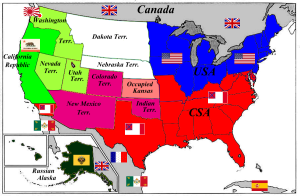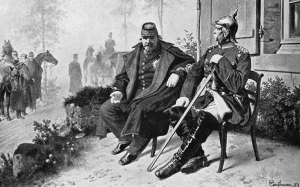Background.
These are some weapons that I’m making available in my games of IHMN, based on the Alternate Timeline I’ve already described in my Blog.
| Shooting | SV Bonus | Range | Hands | Pluck Mod. | Cost | Notes |
| Gatling Pistol | +2 | 9” | 1 | -1 | 8 | Attacks can be split between multiple targets. If fired into a group attacks all targets equally (see 3.3.3) |
| Gatling Rifle | +3 | 24” | 2 | -1 | 12 | Attacks can be split between multiple targets. If fired into a group attacks all targets equally (see 3.3.3) |
| Gatling Machine Gun | +5 | 30” | 4 | -2 | 26 | Attacks can be split between multiple targets. If fired into a group attacks all targets equally (see 3.3.3) |
| Williams Quick Fire Artillery | +5 | 48” | 4 | -3 | 38 | Attacks can be split between multiple targets. If fired into a group attacks all targets equally (see 3.3.3) |
Description.
The Gatling Pistol and Rifle are developed from the Gatling Machine Guns. These are not common, but are available, especially in North America.
The Gatling Machine Gun, is basically as already described in the Rules and is merely listed here for comparison.
The Williams Quick Fire Artillery, is normally mounted on a Field Carriage, as normal Artillery. It may not be carried, even by a Strong Man, as the recoil would make it too inaccurate. It requires a crew of two to use it. If only one crew man is present, it can fire every other turn, as it requires a turn to reload the magazine. If however, it is mounted on a ship, or fixed mounting and belt fed, it may operate each turn with only one crew member. Although this is designed specifically to represent the Williams in this timeline, it could also represent any Quick Fire Artillery from the late 19th Century.
These are my thoughts, but your input is most welcome.
I would like to share the setting I have created for my Steampunk Alternate History and how the events unfolded, leading to the present political situation.
The Crimean War (October 1853 – February 1856), in which Russia lost to an alliance of France, the United Kingdom, the Ottoman Empire, and Sardinia.
The Indian Rebellion/Mutiny (May 1857 to June 1858), the rebellion led to the dissolution of the East India Company in 1858. The country was thereafter directly governed by the crown as the new British Raj.
The Italian Unification (August 1849 to September 1870), a series of campaign’s leading to the removal of Austrian and French influence in the Italian Peninsula and the creation of a unified Kingdom of Italy.
The American Civil War (April 1861 to 1864)
Hostilities began on April 12, 1861, when Confederate forces fired upon Fort Sumter.
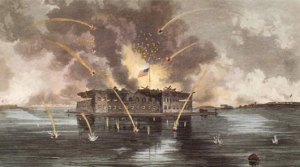
On November 8, 1861, the USS San Jacinto, commanded by Union Captain Charles Wilkes, intercepted the British mail packet RMS Trent and removed, as contraband of war, two Confederate diplomats, James Mason and John Slidell. The envoys were bound for Britain and France to press the
Confederacy’s case for diplomatic recognition and to lobby for possible financial and military support, in the name of cotton diplomacy. In Britain, the public disapproved at this violation of neutral rights and insult to their national honor. The British government took steps to strengthen its military forces in Canada and the Atlantic. President Abraham Lincoln and his top advisors did not want to risk war with Britain over this issue. After several tense weeks, the crisis was resolved when the Lincoln administration released the envoys and disavowed Captain Wilkes’s actions without a formal apology. Mason and Slidell resumed their voyage to Britain. After much negotiation, they arranged for an exchange of Confederate Military technology to be produced and developed under licence in Britain and France, in exchange for credit to purchase weapons and supplies to pursue the war. A deciding factor was the interest that would be paid in cotton and import/export agreements that would avoid any taxation duties between the Confederacy and British Empire. France
negotiated a similar agreement.
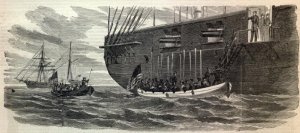
Part of the Military Technology shared, were the blue prints and a working example of the Williams Gun which was classified as a 1-lb cannon. It was designed by Capt. D.R. Williams, of Covington, Kentucky, who later served as an artillery captain with a battery of his design. It was a breech-loading, rapid-fire cannon that was operated by a hand-crank. The barrel was 4 feet long and 1.57-inch caliber. The hand crank opened the sliding breech which allowed the crew to load a round and cap the primer. As the crank was continued, it closed the breech and automatically released the hammer. The effective range was 800 yards but the maximum range was 2000 yards. This was quickly taken into development and trials at the Royal Arsenal, Woolwich. By 1863 the gun and been developed into a true Quick Fire weapon, by adding a overhead magazine, which carried 12 rounds. By the use of these, the rate of fire could reach over 120 rounds per minute. They were quickly put into production and a large consignment was shipped into Savannah, Georgia. From here they were issued to all of the Confederate Field Army’s.
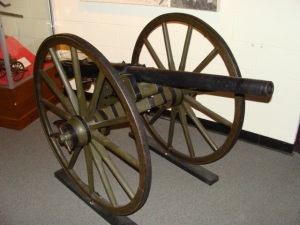
At the Battle of Chancellorsville, April 30 1863 – May 6 1863, these new weapons were first used and rapidly decimated the Union force. The Confederate victory was marred by the loss of General ‘Stonewall’ Jackson, who died on May 10th 1863.
At the later Battle of Gettysburg, July 1 1863 – July 3 1863, the Federal death toll was immense and although the Confederate force was repulsed. It was becoming apparent that the South was gaining the upper hand.
Prior to the defeat of the United States, it had been hoped to sell Russian Alaska to them. But as that time had passed, it had been decided to maintain Alaska as a foot hold to possibly threaten British Canada, or as a base to operate from along the Pacific Coast.
Background
Firstly, I thought I should give you a little of my Wargame Pedigree. I was always interested in ‘Toy Soldiers’ and addicted to all military films and programmes on the television, or at the cinema. My Father and Mother had served in the British Army during World War Two. My Grandfather had served during the Boer War and World War One. So coming from a Military family and hearing all of the tales had been absorbed into my soul.
I remember watching Edward Woodward in Callan, on the BBC during the late 60s, in which he was a spy and relaxed by painting and fighting battles with ‘Toy Soldiers’. I was eager to learn about this. In 1970 I was given my first Wargame book. It was an Introduction to Battle Gaming by Terence Wise. This introduced me to such creatures as Carthaginians and Zouaves, totally unknown to me before. My next acquisition was ‘Battle! Practical Wargaming by Charles Grant. This covered WW2 in detail. So now my collection of plastic Airfix figures, were removed from the garden trenches, where they had served. They were washed off, organised, partially painted and started marching into history.
Since those early days, I have been a member of the local Wargame Club. Acquired hundreds of books, thousands of figures and fought hundreds of tabletop battles. Now I am reaching the age of aches, pains, dimming eyesight and a frustration with complicated rules. I want to return to the fun of the early games. Like an Old Victorian General, I want to return to the actions of my youth and regale tales with my compatriots over a stiff drink and fine cigar. Well, maybe not a real cigar, as I gave up smoking and put on the weight to prove it!
The Rules Used
Now I’m returning to gaming, after a period abroad, so I’m dusting off my Army’s and they are marching into action once again with new vigour.
My favoured rule sets for larger battles are:
Hail Ceaser for the Ancient – Medieval Period
Pike & Shotte for the Renaissance to Marlburian
Black Powder for 1700-1900
Fire & Fury for ACW
My favoured Skirmish rule sets are :
SAGA for Ancient to Renaissance
In Her Majesty’s Name for Steampunk and Victorian
Bolt Action for WW1 & WW2
None of the above rules will suit ‘Rules Lawyers!’ However, if you want to relax, have fun and acquire memorable tales to share, these rules sets should suit you!
Previous rules I have enjoyed but have moved on from are all of the Games Workshop sets. The best of which to me, was WH40k Rogue Trader! That set even told you how to design vehicles and races! A far cry from the insular version that is available these days.
I played DBA and DBM, but lost interest in the minutia of the rules changes and constant army list updates.
I loved Principles of War and still think they are a superb set to use for large campaigns. As a club, I ran the entire 7 Years War as a campaign on a global scale using these rules. With added campaign rules that had everyone backstabbing with gusto. The members even produced weekly tabloids full of propaganda to wind each other up and it was hilarious to umpire. I also ran the Peninsular Campaign using these rules, which again was quite hilarious. The French discovering they could beat the Spanish in detail wherever they were encountered, but only ever controlled the ground they were camped on. Just as in real life!
Fire & Fury, a great set of rules in my opinion. We used them to recreate the Seven Days Campaign, as well as numerous battles, all of which were fun.
Objective
Over the coming weeks and months, I will be sharing the mustering and updating of my forces. My acquisitions, conversions and painting of figures and scenery.
My current focus is
1) 28mm Napoleonic, using Black Powder
2) 28mm Dark Ages, using SAGA and The Crescent & The Cross SAGA
3) 28mm Steampunk, using In her Majesty’s Name
In particular, I will be sharing my developing world of Steampunk and the alternative history I am using for it. Along with the Company’s, Weapon’s and Creature’s I organise for it.
May Your Dice Roll Well!
